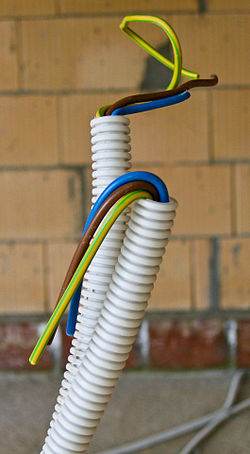Regional codes
This section needs additional citations for verification .(April 2021) |

Wiring installation codes and regulations are intended to protect people and property from electrical shock and fire hazards. They are usually based on a model code (with or without local amendments) produced by a national or international standards organisation, such as the IEC.
Australia and New Zealand
In Australia and New Zealand, the AS/NZS 3000 standard, commonly known as the "wiring rules", specifies requirements for the selection and installation of electrical equipment, and the design and testing of such installations. The standard is mandatory in both New Zealand and Australia; therefore, all electrical work covered by the standard must comply.
Europe
In European countries, an attempt has been made to harmonise national wiring standards in an IEC standard, IEC 60364 Electrical Installations for Buildings. Hence national standards follow an identical system of sections and chapters. However, this standard is not written in such language that it can readily be adopted as a national wiring code. Neither is it designed for field use by electrical tradespeople and inspectors for testing compliance with national wiring standards. By contrast, national codes, such as the NEC or CSA C22.1, generally exemplify the common objectives of IEC 60364, but provide specific rules in a form that allows for guidance of those installing and inspecting electrical systems.
Belgium
RGIE (fr) (Réglement Général sur les Installations Électriques) is used for installations in Belgium. AREI (nl) (Algemeen Reglement Elektrische Installaties) is used for installations in Flanders, Belgium.
France
NF C 15-100 (fr) is used for low voltage installations in France
Germany
The VDE is the organisation responsible for the promulgation of electrical standards and safety specifications. DIN VDE 0100 is the German wiring regulations document harmonised with IEC 60364. In Germany, blue can also mean phase or switched phase.
Sweden
In Sweden, IEC 60364 is implemented through the national standard SS-436 40 000.
United Kingdom
In the United Kingdom, wiring installations are regulated by the British Standard known as BS 7671 Requirements for Electrical Installations: IET Wiring Regulations, which are harmonised with IEC 60364. The first edition was published in 1882. BS 7671 is an industry standard and as such is not itself statutory, however legislation in the form of UK Building Regulations requires that domestic installations conform to a safe standard, and official guidance accompanying this statutory regulation points to following BS 7671 as one way to comply.
BS 7671 is also used as a national standard by Mauritius, St Lucia, Saint Vincent and the Grenadines, Sierra Leone, Singapore, Sri Lanka, Trinidad and Tobago, Uganda and Cyprus.
North America
The first electrical codes in the United States originated in New York in 1881 to regulate installations of electric lighting. Since 1897 the US National Fire Protection Association, a private non-profit association formed by insurance companies, has published the National Electrical Code (NEC). States, counties or cities often include the NEC in their local building codes by reference along with local differences. The NEC is modified every three years. It is a consensus code considering suggestions from interested parties. The proposals are studied by committees of engineers, tradesmen, manufacturer representatives, fire fighters, and other invitees.
Since 1927, the Canadian Standards Association (CSA) has produced the Canadian Safety Standard for Electrical Installations, which is the basis for provincial electrical codes. The CSA also produces the Canadian Electrical Code, the 2006 edition of which references IEC 60364 (Electrical Installations for Buildings) and states that the code addresses the fundamental principles of electrical protection in Section 131. The Canadian code reprints Chapter 13 of IEC 60364, but there are no numerical criteria listed in that chapter to assess the adequacy of any electrical installation.
Although the US and Canadian national standards deal with the same physical phenomena and broadly similar objectives, they differ occasionally in technical detail. As part of the North American Free Trade Agreement (NAFTA) program, US and Canadian standards are slowly converging toward each other, in a process known as harmonisation.
Mexico and Costa Rica follow the US National Electrical Code.
South America
Venezuela and Colombia follow the US National Electrical Code.
India
India is regulated by the so-called Central Electricity Authority Regulations (CEAR).

